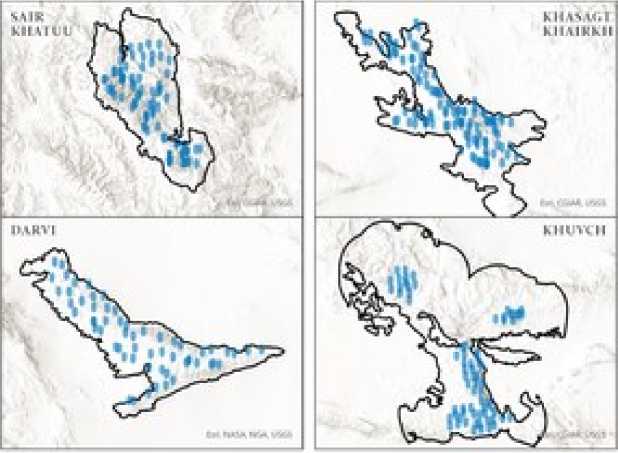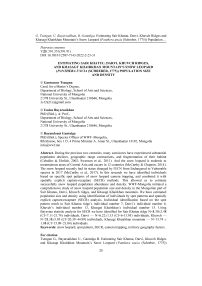Estimating Sair Khatuu, Darvi, Khuvch ridges, and Khasagt Khairkhan mountain's snow leopard (Panthera uncia (Schreber, 1775)) population size and density
Автор: Tsengun Gantumur, Bayarsaikhan Uudus, Gantulga Bayandonoi
Журнал: Вестник Бурятского государственного университета. Биология, география @vestnik-bsu-biology-geography
Рубрика: Биология
Статья в выпуске: 2, 2022 года.
Бесплатный доступ
During the previous two centuries, many carnivores have experienced substantial population declines, geographic range contractions, and fragmentation of their habitat (Ceballos & Ehrlich, 2002; Swenson et al., 2011). And the snow leopard is endemic to mountainous areas of Central Asia and occurs in 12 countries (McCarthy & Chapron, 2014). The snow leopard recently had its status changed by IUCN from Endangered to Vulnerable species in 2017 (McCarthy et al., 2017). In this research we have identified individuals based on specific spot patterns of snow leopard camera trapping, and combined it with spatially explicit capture-recapture (SECR) methods. This allowed us to estimate successfully snow leopard population abundance and density. WWF-Mongolia initiated a comprehensive study of snow leopard population size and density in the Mongolian part of Sair Khatuu, Darvi, Khuvch ridges, and Khasagt Khairkhan mountain. We have estimated population size and density using identification of individuals by spot patterns and spatially explicit capture-recapture (SECR) analysis. Individual identification based on the spot pattern result in Sair Khatuu ridge's individual number 7, Darvi's individual number 6, Khuvch's individual number 13, Khasgat Khairkhan's individual number 15. Using Bayesian statistic analysis for SECR we have identified for Sair Khatuu ridge N=8.30±2.48 (CI=7.11-21.74) individuals, Darvi - N=6.22±1.15 (CI=6-13.95) individuals, Khuvch - N=28.38±5.95 (CI=20.39-44.99) individuals, Khasagt Khairkhan mountain - N=15.74 ± 1.8 (CI=15.09-21.04) individuals.
Snow leopard, spot pattern, secr, camera trapping, territory geography factors, mongolia
Короткий адрес: https://sciup.org/148325384
IDR: 148325384 | УДК: 591.551(591.91) | DOI: 10.18101/2587-7143-2022-2-25-31
Текст научной статьи Estimating Sair Khatuu, Darvi, Khuvch ridges, and Khasagt Khairkhan mountain's snow leopard (Panthera uncia (Schreber, 1775)) population size and density
Tsengun G., Bayarsaikhan U., Gantulga B. Estimating Sair Khatuu, Darvi, Khuvch Ridges and Khasagt Khairkhan Mountain’s Snow Leopard ( Panthera uncia (Schreber, 1775))
Population Size and Density. Bulletin of Buryat State University. Biology, Geography. 2022; 2: 25–31.
Study area
Mongolia is home to the second-largest population of snow leopards in the world [7]. It is estimated that there are approximately 1,000 snow leopards across the Mongolian Altai, Gobi Altai, Khangai mountain ranges, and isolated mountains of Trans-Altai Gobi and Khuvsgul Mountains containing around 103,000 km2 area [6; 7]. In figure 1 shows automat camera locations in Sair Khatuu ridge, Darvi ridge, Khuvch ridge, and Khasagt Khairkhan mountain respectively. These areas are Mongolian snow leopard population distribution’s important region. The assessment found the Mongolian country’s snow leopard population to be stable and confirmed the presence of approximately 953 snow leopard [1].

Fig. 1. Located automatic cameras in the study area
Research methodology
We collected field data using automatic cameras for 90 days. Estimating the snow leopard’s population size and density we used 2 types of methods. The first type is based on the snow leopard pelage's specific pattern. The second method is using spatially explicit capture-recapture (SECR). We using for identified snow leopard individual from 433 photos from snow leopard detected camera in Sair Khatuu. Using for identified individuals 153 photos from snow leopard detected camera in Darvi ridge. Khuvch ridge in using snow leopard detected camera’s 260 photos for identified individual. Detected snow leopard camera’s 767 snow photos of snow leopard using for identified individual in Khasagt Khairkhan mountain. Showing Identifying individual based on spot pattern in (figure 2). We examined each photograph for clarity, subject orientation, and framing to locate unique markings useful for identification based on guidelines modified from Heilbrun [4] shows in below list:
-
1. A photograph was considered an initial capture only if it could not be positively matched with a previously photographed individual. 2. A recapture need not have been a photograph of the entire animal, but one that could be positively matched to a previously identified individual. 3. A poor photograph or one that could not be classified.
-
2. A recapture need not have been a photograph of the entire animal, but one that could be positively matched to a previously identified individual.
-
3. A poor photograph or one that could not be classified as an initial or recaptured individual was classified as a non capture.
-
4. Areas used for identification consisted of uniquely shaped rosettes or spots, or groupings thereof, and their spatial arrangement on the forelimbs, flanks, and dorsal surface of the tail.
-
5. Distinct areas used for identification were classified as either primary or secondary features. A single primary feature was designated for each photograph and was defined as the most distinct and clearly visible group of markings or individual marks useful for identification. All other useful markings were classified as secondary features.
-
6. A positive identification was made by comparing the primary feature and at least one secondary feature to determine if the animal was an initial capture or recapture.
-
7. Identification of 1 different feature was considered sufficient to determine that 2 photographs depicted different individuals.

Cam-335-individual-4 Cam-382-individual-4

Cam-414-individual-11 Cam-417-individual-11
Fig. 2. Identification of individuals based on spot patterns.
Khasagt Khairkhan mountain’s snow leopard individual 4 detected camera 335 and camera 382, individual 11 detected camera 414 and 417
Statistical analysis using “SECR” package in R Software program. Statistically analyze fitting 20–25 models for each study area model selection established on 7 covariates quantitative data which are Snow leopard detected and non-detected area’s difference of geography data, national protected area (NPA), ibex density, elevation, ruggedness, aspect, snow leopard habitat suit. Our covariates were established on snow leopard’s prey and habitat.
ResultsCapture success
We are estimating snow leopard population size and density using automatic camera’s photography. In 2020 we located automatic cameras 90 days each study area. Sair Khatuu ridge’s area size is 2658 km2, the highest elevation 3570 m Darvi ridge’s study area size is 1776 km2, the highest elevation 2660 m Khuvch ridge’s study area size is 10060 km2 , the highest elevation 2759 m, Khasagt Khairkhan mountain’s study area size is 5167 km2, the highest elevation 3073 m.
Table 1
|
Study area |
DN |
DV |
DS |
N |
|
Sair Khatuu ridge |
175 |
29 |
87 |
15 |
|
Darvi ridge |
59 |
10 |
18 |
7 |
|
Khuvch ridge |
70 |
22 |
43 |
13 |
|
Khasagt Khairkhan mountain |
175 |
32 |
87 |
15 |
DN — a total of located camera numbers, DV — detected snow leopard camera numbers, DS — a total of detection snow leopard, N — a total snow leopard individuals
Population size and density based on identification of individual spot patterns
Individual identification of snow leopards based on their pelage on specific spot patterns. Estimated population density
Table 2
|
Study area names |
Population size based on a spot pattern |
Snow leopard population density 100km2 |
|
Sair Khatuu ridge |
7 |
0.23 |
|
Khuvch ridge |
13 |
0.28 |
|
Darvi ridge |
6 |
0.46 |
|
Khasagt Khairkhan mountain |
15 |
0.30 |
Population and territory size using spatial explicit capture-recapture (SECR)
Table 3
Bayesian statistical analysis for SECR estimating population size and one snow leopard individual’s territory radius
95% confidence interval
Influence factors on snow leopard population size and density
Snow leopard population size and density depend on geography factors. Specially elevation, ruggedness, aspect and slope effect on snow leopard’s habitat selection. We have fitted the model in each study area using “SECR” package in R software programm showing table 4. We fitted 25 models in Sair Khatuu ridge, 20 models in Khasagt Khairkhan mountain, 19 models in Darvi ridge, 23 models in Khuvch ridge. Model rankings are based on Akaike’s Information Criterion (AIC).
Table 4
|
Study area |
Covariate models |
Best model ranked by AIC |
AICwt (%) |
|
Sair Khatuu |
|||
|
ridge |
HS+NDVI+λSLOcc |
SairKhatuu.HabitatSuitNDVI.lambdaSLOcc |
0.6006 |
|
Darvi ridge |
E+ID+λR+ |
Darvi.ElevationIbexDensity.lambdaRuggedn |
0.2422 |
|
ϭIbexOcc |
ess.sigmaIbexOcc |
||
|
Khuvch ridge |
R+ϭS |
Khuvch.ruggedness.sigmaSlope |
0.2421 |
|
Khasagt |
|||
|
Khairkhan |
SLOcc+NDVI+λS |
Khasagt.SLOccNDVI.lambdaSlope |
0.3539 |
|
mountain |
Weighted by AIC best models of each study area. HS — habitat suit, LOcc — snow leopard
|
occupancy, E — elevation, ID R — ruggedness, S — slope, Lamda — mean of territory radius |
— ibexdensity, IbexOcc — ibex occupaqncy, detection probability, Sigma — one snow leopard's |
Conclusion
Located automatic camera numbers, study area size, camera trap positions, and covariate quantity data are whereas fitted models are fellowless each study area also similar models fitting is not relevant. Influence to snow leopard population size and density geography factors are different in each study area. In addition prey abundance, livestock grazing, illegal hunting, human activities affected in Snow leopard population size and density therefore need to improve conservation initiative and management of snow leopard. Estimating population size and density using automatic camera pictures for Identification individual based on snow leopard spot pattern cannot determine completely snow leopard population in whole study area therefore we combined analysis (SECR) with identifying individual by spot pattern.
Список литературы Estimating Sair Khatuu, Darvi, Khuvch ridges, and Khasagt Khairkhan mountain's snow leopard (Panthera uncia (Schreber, 1775)) population size and density
- Nationwide Snow Leopard Population Assessment of Mongolia: Key Findings. October 2020. 38 p.
- McCarthy T., Mallon D., Jackson R., Zahler P., & McCarthy K. Panthera uncia, Snow Leopard // The IUCN Red List of Threatened Species. 2017. No. 8235. Р. 27. URL: http://dx.doi.org.
- Ceballos G., & Ehrlich P. R. Mammal Population Losses and the Extinction Crisis // Science. 2002. No. 296(5569). Р. 904-907. URL:.
- Heilbrun R. D., Silvy N. J., Tewes M. E., & Peterson M. J. Using Automatically Triggered Cameras to Individually Identify Bobcats // Wildlife Society Bulletin. 2003. No. 31(3). Р. 748-755.
- McCarthy T. M., & Chapron G. Snow Leopard Survival Strategy: Revised 2014 Version // Snow Leopard Network. 2014. Р. 1-145.
- Mishra C., Allen P., McCarthy T. O. M., Madhusudan M. D., Bayarjargal A., & Prins, H. H. T. The Role of Incentive Programs in Conserving the Snow Leopard\\rEl Papel de Programas de Incentivos en la Conservation del Uncia uncial // Conservation Biology. 2003. No. 17(6). Р. 1512-1520. URL: http://dx.doi.org.
- Munkhtsog B., Purevjav L., McCarthy T., & Bayrakgsmith R. Snow Leopards. Biodiversity of the World: Conservation from Genes to Landscapes. 2016. Р. 493-500. URL: 10.1016/B978-0-12-802213-9.00039-0 (accessed 16.04.2022).
- Swenson J. E., Taberlet P., & Bellemain E. Genetics and Conservation of European Brown Bears Ursus Arctos // Mammal Review. 2011. No. 41(2). Р. 87-98. URL: 10.1111/j.1365-2907.2010.00179.x (accessed 20.05.2022).


